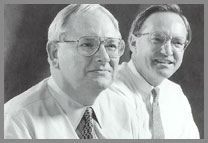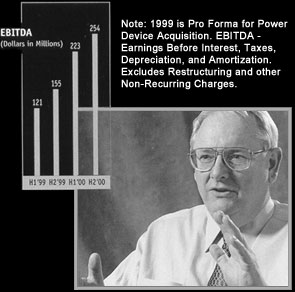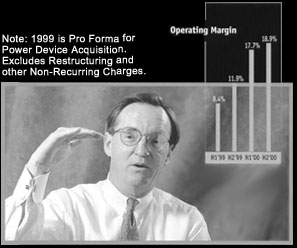|
Kirk Pond, Chairman,
President and Chief
Executive Officer,
discusses Fairchild's
future with
Joe Martin, Executive Vice
President and Chief
Financial Officer.
|
 |

Question: Kirk, you have led Fairchild with a strategy
to win in the multi-market segment for about four years now. How is it
going?
Kirk: Our
strategy is a winner. We focus on providing high performance products
to multiple end markets. 2000 was a watershed year for Fairchild. All
of our hard work since 1997-building our work force with top notch employees,
developing new products, making key acquisitions, investing in our manufacturing
facilities-positioned us for great success in 2000. We had phenomenal
growth across all of our product segments. We not only grew, but we outgrew
many of our market segments and competitors.
Question: Joe, what do you see as your major accomplishments?
Joe: I think
one key point is how well our business model has worked. When we set up
Fairchild, we knew we had to grow new product sales, keep our factories
fully utilized, invest strongly in R&D, control SG&A spending, and incrementally
spend capital where we get immediate sales leverage. By doing those things
well, we believed we could operate this business with operating margins
in the 15-20 percent range, while growing sales at or above the rate of
the industry. In 2000 we did all of those things, and our results speak
for themselves.

Question: Kirk, tell
us more about Fairchild's new product focus.
Kirk: New products
are my favorite topic. From day one we have focused internally on maximizing
our R&D and capital to develop new products in our key target areas. Our
strategy is to choose applications, such as power management, power conversion,
and data and signal interface that are necessary across many different
end markets and offer high growth potential. For example, managing the
power in a cellular phone is really not very different from managing power
in a notebook computer or digital camera...at least in the way that our
products contribute to the solution. We then work closely with the leading
customers who design these applications, find out what they want and try
to develop it before our competitors do. We introduced more than 450 new
products this year, focusing on power MOSFETs, power analog, interface,
and advanced logic. Our new product sales accounted for 34% of sales at
the end of 2000, up from 5% in 1997. New products tend to have higher
sales growth and higher gross margins. New products also cement tighter
relationships with key customers, providing Fairchild future opportunities
to develop next generation products ahead of our competitors.
Question: Joe, what
about the other side of Fairchild's growth strategy, making strategic
acquisitions?
Joe: We've
put together a great track record of key acquisitions over the past few
years. Fairchild focuses on acquisitions that will broaden and complement
our product lines, allow us to enter new markets, strengthen our regional
market share and are financially sound. This year we acquired QT Optoelectronics,
giving us entry into the last major target market segment in which we
were not a player. The optoelectronics market topped $6 billion in 2000,
and we now have the ability to serve over half of that market with our
lines of optocouplers, lamps, displays, and infrared products. We also
strengthened our analog product portfolio by acquiring Kota Microcircuits,
a supplier of high performance op amps, and by acquiring the power management
business of Micro Linear. And, in January 2001, we announced our agreement
to acquire the discrete power business of Intersil. This really strengthens
our power MOSFET and IGBT lines, and increases our penetration into industrial
and automotive power applications. We expect that these acquisitions combined
with our internal development will increase our total power product sales
to more than one billion dollars in 2001.
 Question:
Kirk and Joe, what do you see as the major priorities for the next couple
of years? Question:
Kirk and Joe, what do you see as the major priorities for the next couple
of years?
Kirk: On
the acquisition front, our major goals are to continue building our power
businesses, and to continue our global expansion, particularly looking
at Japan and Europe-two regions with tremendous growth potential for Fairchild's
products. We're a leading power semiconductor supplier now, and when we
complete the acquisition of the Intersil discrete power business, we will
rank as one of the top two worldwide power MOSFET suppliers, and among
the top five suppliers in the seven billion dollar power discrete market.
Our $400 million analog business enhances our power position, and also
makes us one of the leading standard linear suppliers in the world. We
believe our current overall portfolio addresses a market that was worth
roughly $40 billion in 2000. That means we have about 4-5% market share.
We believe the total multi-market segment, including discretes,
optoelectronics, standard linear, logic, and interface, will grow to over
$60 billion within the next two to three years. Our goal is to be the
leader of that segment, and become dominant with at least a 10% share.
We have a clear and focused strategy, with a proven track record and considerable
future growth potential. We have talented employees who understand our
mission and how to quickly and effectively execute on our goals.
Joe: Kirk hit the nail on the head.
We plan to continue to build the business and heat the competition, just
as we've executed for the past four years. And, we need to continue to
tell investors our story. Considering our mix of power, analog, and interface
sales, we believe our stock should be valued at least on par with our
peers. Fairchild has an exciting future. We're aiming at a $60 billion
market that's servicing a one trillion dollar electronics industry. If
you combine our new product development with the potential acquisitions
we are looking at, you can't help but be really excited.
Kirk: We're the leaders in our market now. Our market is growing and we plan to extend
our leadership. The future looks very bright. Our power, interface, and
optoelectronic products are critical to just about every kind of electronic
system you can think of. We've had a phenomenally successful first four
years, and we plan to continue our success.
|